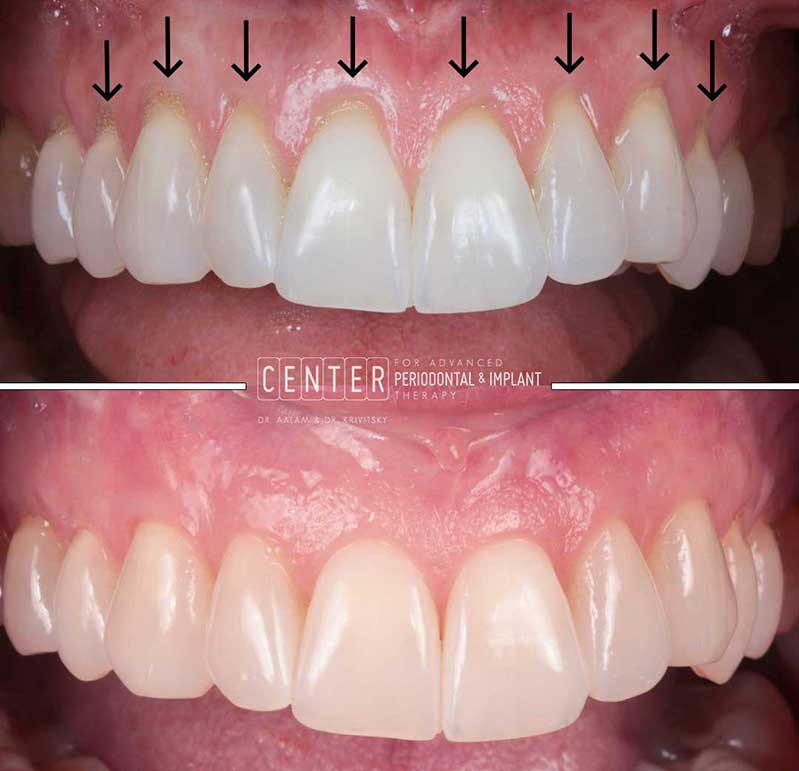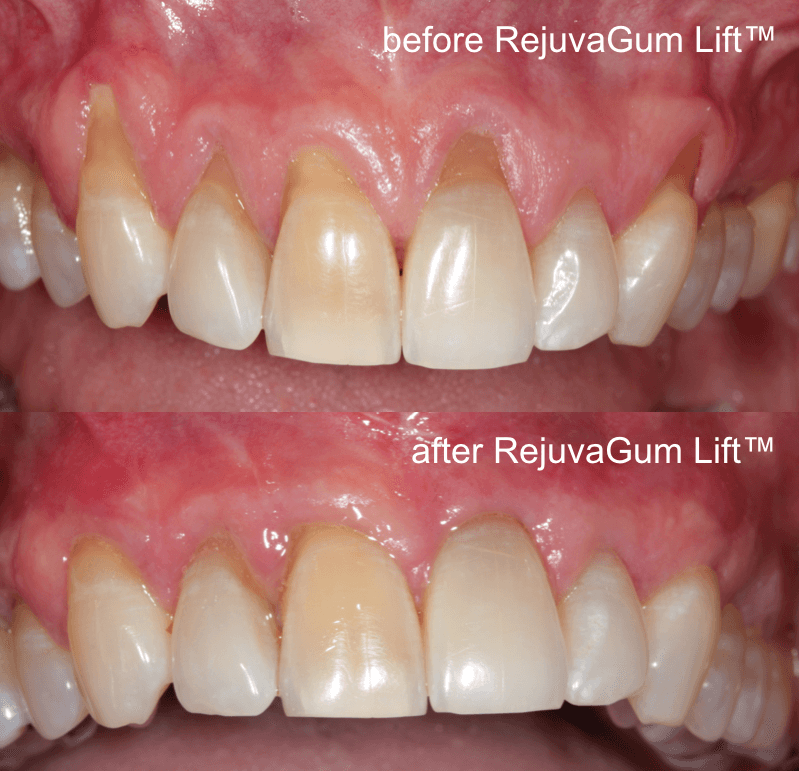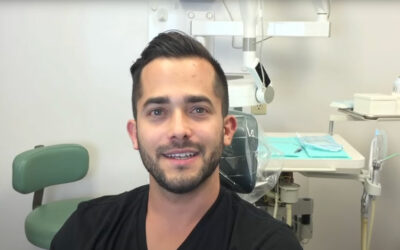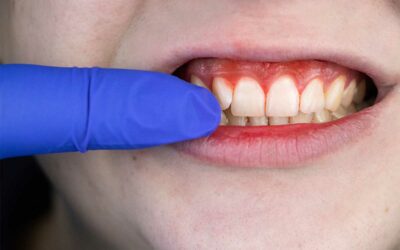Gum Surgery Can Enhance Your Smile And Rescue Your Teeth
What is Gum Recession?
Gum recession is when the gums around your teeth start to pull back and expose the tooth root. Roots aren’t meant to withstand the stimuli that tooth enamel does. As a result, they tend to experience pain or sensitivity when you eat, drink, or brush your teeth.
Receding gums can be hard to catch if the recession is small. But over time, gum tissues will pull back so far that it’s possible to see the yellower root of the tooth between the gums and white enamel.
Some people refer to gum recession as being “long in the tooth.” But receding gums aren’t a rite of passage into adulthood like some people think they are. Today’s advanced gum recession treatment techniques and preventative strategies can help you protect your mouth, prevent advanced gum disease, and save your teeth for a lifetime.
What Causes Receding Gums?
There are several reasons why patients see receding gums around their teeth or dental implants:
Gum Disease
Gum disease (periodontitis) is the leading cause of tooth loss in adults. It also causes gingiva (gum tissue) to pull away from teeth and detach from the tooth root. In turn, the bone underneath your gums also begins to deteriorate. If you have bleeding gums, bad breath, or heavy tartar buildup, you may have gum disease. Regular professional cleanings can help remove the bacteria responsible for loss of gum attachment.
Aggressive Tooth Brushing
Overzealous tooth brushing isn’t the best way to prevent gum disease or tooth decay. It can actually be damaging to tooth enamel and gums. Even though there isn’t any pain, brushing too hard can wear through your tooth, creating notches in the enamel and causing the gums to pull back, away from where you’re brushing. But here’s the bad news: your gums don’t grow back. Always brush with a soft or extra-soft toothbrush, and don’t push too hard when brushing.
Crooked Teeth
Crowded or crooked teeth tend to pull at your gum tissues from various directions. This can cause the margins of your gums to pull down, away from your pearly whites. One or several teeth can be affected, depending on the shape of your jaw.


Why Do I Need Gum Surgery?
Your gum tissue helps frame, protect, and stabilize natural teeth. But with gum disease or receding gums, you lose the protective tissue around your tooth roots. To save your teeth from additional complications, gum surgery options like grafting or graftless therapy are recommended.
People who have recently recovered from periodontal disease are prime candidates for gum treatment. Because as their gummy tissues begin to pull back, it can weaken their jawbone, cause loose teeth, and reshape the frame around their smile. Because healthy gum tissue and gumlines are just as vital to a stable and attractive smile as healthy teeth are. Unfortunately, gum disease and recession often go overlooked because the infection isn’t actually in the tooth. As a result, patients lose their natural teeth and need tooth replacements like partials, dentures, or implants.
What Gum Surgery Options Do I Have?
Typically, the traditional procedure for repairing areas of gum recession is to graft over the root or surgically reshape gums to better protect the tooth. This could mean placing a graft and suturing it into place. Unfortunately, using donor tissue from another place in your mouth can be extremely uncomfortable. In turn, our Los Angeles periodentist team will likely recommend donor tissue or an advanced method, like RejuvaGum treatment.
Ultimately, it’s important to treat your gum tissue quickly, before too much gum tissue is lost. Otherwise, you increase your risk of tooth loss, tooth decay across root surfaces, sensitive or discolored teeth, and advancing gum disease.
RejuvaGum Procedures are Gentler on Your Smile
RejuvaGum treatment isn’t like more aggressive gum surgery. Instead, we use a small sample of the patient’s blood to stimulate faster healing and regeneration of locations affected by the recession of the gums. Because of this approach, no tissue graft is taken from the roof of the mouth, eliminating an often painful procedure and decreasing recovery time.
Using advanced platelet-rich fibrin (A-PRF) naturally restores lost gum tissue, speeds up the body’s natural healing process, and ultimately achieves faster results. So if you’re someone who has previously experienced bone loss or periodontal disease, RejuvaGum can help your smile look whole and healthy again.
Not only does it enhance your smile’s appearance, but it also improves your overall oral health by reducing your risk of tooth decay, deep pockets, and sensitivity in the affected tooth. Plus, it’s a boost to your self-confidence when your gums frame your smile just right.
How Does RejuvaGum Treatment Work?
With traditional connective tissue graft treatment, donor tissue or removal from the roof of patinets mouths are usually required. But RejuvaGum therapy in Los Angeles uses your body’s healing properties to improve gum tissue treatments while speeding up the recovery process. In this case, platelet-rich fibrin (PRF) from your own body is placed into the gum tissue being treated. This measure reduces discomfort, speeds up healing, and improves the overall success of your treatment.
PRF is used for a variety of soft tissue treatments, including after oral or gum surgery, to jumpstart the healing process. That way, we can reshape your soft tissues to frame your teeth, covering any exposed roots in the process.
Restore Your Smile, Protect Your Teeth
Center for Advanced Periodontal & Implant Therapy offers comprehensive treatments for gum loss and tooth preservation. Our Los Angeles dental specialists are experts when it comes to a healthy mouth and beautiful smile. If you have receding gum tissue or exposed teeth, contact our office today to request an appointment. Learn more about how RejuvaGum Lift and PRF therapy can help you smile with confidence.
You May Also Like...
Stem Cells Tissue Regeneration: An Alternative to Classic Gum Graft
Gum recession is a common dental problem that affects millions of people worldwide. This condition occurs when the...
What are the Stages of Periodontal Disease?
Periodontal disease (gum disease) is one of the leading causes of tooth loss in Los Angeles. Fortunately, recognizing...
TOOTH ROOT EXPOSURE
Your Tooth Root is Exposed. Now What? Many people do not notice that they suffer from receding gums and tooth root...



